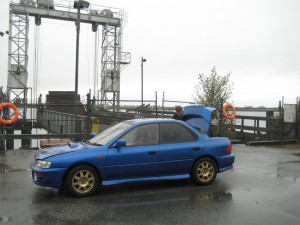My Import Story, Part 6
Apparently this turned into a huge series. This is the last chapter.
Getting your car home!
So, you've bought a car, shipped it, picked it up, and now you need to get it home. A few ways to do this. There are car carriers, but they tend to hate JDMs. Too bad. The fact they ship with no gas and usually have dead batteries when they get here doesn't help.
But, what most people do: have a great excuse for a road trip.
I only have one piece of advice for this part of the import process: In bold, and all caps. KEEP YOUR EYES ON THE OIL TEMPERATURE. I've heard of a few cars that have died 100km from their final destination. Due diligence would be to check your oil every time you fill up the tank, a good idea but a bit of overkill.
Getting your car insured
BC and Alberta require an OOP - Out of Province inspection. Other province might, but I don't know about that. Manitoba I do know about. Just a regular safety inspection will do. Your problem will be getting someone to look at your car, but that's a whole story on it's own. Compliance is also another story. Once day....
Paperwork you will need once you have your inspection completed:
- Something that says how much you paid for the car, so you can be taxed on it (again)
- Transfer of ownership documents with the address of the previous owner
- Deregistration from Japan
- Translated deregistration from Japan
- Your Form 1 from Transport Canada (saying it's been imported properly)
- Your completed safety
And that's really it. You're plated and ready to go! Congratulations.
Now this all sounds like quite a lot... but it's not. And it's worth it.
Next time: A summary, followed by a quiz.
My Import Story, Part 5
So. You've bought and paid for a car, cleared it though customs, now you want to pick it up. If you did all the work yourself, the car will be at the docks in a imported car common area. If you went through a bonded shipping agency, the car will be at their warehouse. Mine was the latter.
Before you even leave for the docks, you'll need temporary car insurance. Pretty simple to get. I forget which documents you need to get one. Probably the VIN/Chassis code for the car, and some proof that you own the car. In Manitoba you can get temporary insurance to only come into effect on a certain date.... so make it the day you get your car. Temporary insurance isn't cheap, so you probably don't want to pay for something you're not using.
This is what I looked like when I picked up my car:
That's a bit of an embarrassing photo. I think that everyone that picks up their car at the dock looks like that though. Below you'll see a picture of me filling the gas and doing the checks. The background you'll see what a prairie boy calls the ocean. That's awesome.
So, your car has been in shipping for about a month now. And you've never seen it in real life before. And if you're like me, you're about to drive it 2000km. You'd be an idiot to not check it out before you start driving it.
First off, these cars ship with the absolute minimum amount of fuel. Probably want to bring a jerry can of premium with you. Why premium? The gas is a bit old, and you don't know what they filled it with. Be nice to your car, it's the new kid in town.
Also, your battery might be dead, or lost its charged. Bring booster cables, or something to boost your car with.
Then, just some regular check.... here's what I did for a checklist.
- Fill up the tank.
- Check the oil
- Make sure there is coolant in the reservoir
- Make sure they're coolant in the radiator (remove coolant cap, make sure it's full)
- Try to start it... probably boost it.
- Let the car run... any weird sounds?
- Check brake fluid, move the car and make sure it stops (usually not an issue, but...)
- Check power steering fluid
- Make sure all lights work (especially brake lights). Again, not usually an issue, but you don't know.
- Check windshield wipers and washing fluid.
Am I pedantic? Yes. Have I seen this car before or know anything about it? No. They're all simple checks that can save you from a world of hurt later on into life. Just do it. Worst case scenario you can brag about how great your car was right off the boat.
Summary:
Bring temporary insurance, gas and booster cables. Bring oil, coolant, brake and washer fluid if you're feeling _really_ unlucky.
And there's still more. If you're most Canadians, you don't live in or around Vancouver. So, the ride home and insurance is coming up!
My Import Story, Part 4
So, you've bought a new car... you've paid for your new car, now for shipping.
Brave Auto (I sound like a broken record) does container sharing within the company. Four customers buy cars, and they get shipped out together. This is really one of the cheapest and safest routes to go. Again, Brave Auto uses 'CIF' purchasing, so the shipping is included.
With Brave Auto's container sharing, the containers go to a shipping yard to be unstuffed (the technical term).
Other routes to take are RO/RO - roll on, roll off. Basically, your car will be shipped with some other random cars that are around. Apparently it's a hotbed of theft.
However you ship it, you will need to get it though customs. Because it's 15 years old you can bypass the RIV process (and get an RHD because of that!), but it's still a good idea to get a customs clearing agency to do the work for you.
The things that need to be done for a 15-year old car are a little different than a RIV process car, thought some steps are similar.
You need to get a soil inspection. No foreign soil allowed into the country. They will send your car back for this. And you have to pay tax on it (for the first time), of course. And a border agency fellow has to come and look at it... make sure there's no people in the trunk, or anything crazy like that.
You'll dig through some paperwork, eventually ending in a 'Form 1', which is pretty much just Transport Canada saying that it's allowed through the border... they check the 'it's 15 years old' box, and it's done!
You'll end up with a stack of papers. These should include:
- The completed Form 1 (heck yes it's 15 years or older)
- A deregistration document in Japanese
- A translated deregistration document. That or you'll need to get it translated.


